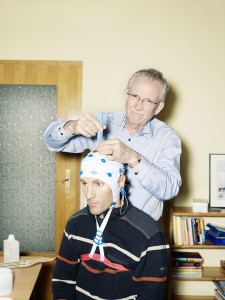Biofeedback
Biofeedback is based upon the concept of “feedback”. Measured information about an individual is fed back to that same individual about their physiology. Biofeedback has been likened to a mirror.
For example, a person sticks a thermometer in their mouth. They take the thermometer out to see what their body temperature is because they are unable to judge for themselves what is good or bad. At this point, it is just a measuring device. The device becomes a tool when the person attempts to affect the temperature on the thermometer.
Much of what we do in life is about patterns. With biofeedback we can learn how to interrupt some of these automatic response patterns. We can use the biofeedback to observe how our bodies respond and then we can learn how to affect these responses on our own. The biofeedback coach/trainer will show the individual how they can do this.
As a person becomes calmer they can then learn how to focus better, be calmer, be more balanced and have more energy. Eventually the person learns how to depend on themselves and no longer needs the biofeedback.
Biofeedback is a tool. It is not a magic wand or pill.
It helps people to become aware of how they respond, learn to recognize the messages(symptoms) and then to change how they respond.
A coach trainer guides a person through this process with encouragement, support and understanding of the process. There a good trainer will have trained themselves with these tools.
The cool thing about biofeedback is that it is non invasive. We put nothing in you. No medications and thus no side effects. The second thing is that it is not a therapy. It is a training. The person learns how to take their lives into their own hands. Many therapies etc are done to the person where there is no learning and often creates a dependence.($) I tell my clients I am doing my job when the do not have to see me anymore. My job is to help people become independent.
HRV -Heartrat Variabilty
The biofeedback that I use is heart rate variability(HRV)
Neurofeedback
The key word is feedback. Information about an individual is fed back to that individual. In the case of neurofeedback, information about the electrical activity, in a person’s brain is fed back to that individual.
Human brains produce electricity from the chemical activity/neurons in the brains. This electrical activity can be read or measured by placing sensors on a person’s scalp. This electrical activity is then filtered and amplified and is converted into an animation on a computer. As an individual watches the animation/brain waves that individual begins to learn how to change how they feel or think.
The brain has been mapped and generally it is known, what parts of the brain are responsible for various functions. A sensor is placed on an area of the scalp close to the part of the brain that is responsible for a function that may be affected and improved. Goals are set and the person then tries to produce activity in that area of brain. If the person produces the correct activity then they are rewarded with a sound and or a visual activity on the computer monitor.
The key aspects of this training is that it is non invasive; nothing is put into the brain. It acts like a mirror and as the person looks at the mirror they can learn how to change how their brain functions.
The training, may take some time depending on the situation. The changes more often than not are subtle and are permanent. In some cases the changes can be almost immediate and dramatic.
Brain Mapping
QEEG (Quantitative Electroencephalograph) also known as brain mapping is a dynamic tool that can be used to measure the efficiency of electrical interaction between the various regions of the brain. These findings provide a “road map” which guides us in providing the most effective and cost efficient neurofeedback training .
Brain mapping is a painless and non-invasive procedure. Sensors are gently placed on a person’s scalp. The person’s brainwave activity is monitored and recorded. The data collected is presented in a comprehensive report that illustrates a person’s brainwave activity and identifies areas that may affect a person’s performance.
Neurostimulation
Neurostimulation simply means a stimulation (such as electromagnetic fields, direct current, or alternating current) that is applied to the brain either directly or, in our case, indirectly.
pEMF
pEMF stands for pulsed ElectroMagnetic Field. This is what we can use to stimulate the brain. This field is similar to one generated by any electrical device. We can show the brain specific frequencies for it to learn.
tDCS/tACS/tRNS
tDCS/tACS/tRNS stands for Transcranial Direct Current Stimulation/Transcranial Alternating Current Stimulation/Transcranial Random Noise Stimulation. The tDCS, as we call it, applies a very low current through two electrodes that are attached to the head/body. This current can be used to help the activation of various cell types as well as teach them what frequencies to generate themselves.
QEEG helping with Stimulation
Using a QEEG, we can generate a map of a brain that can then be compared to a normative database. This helps to show what frequencies a brain may be overactive or deficient in, allowing us to target the training options (pEMF/tDCS/tACS/tRNS).

